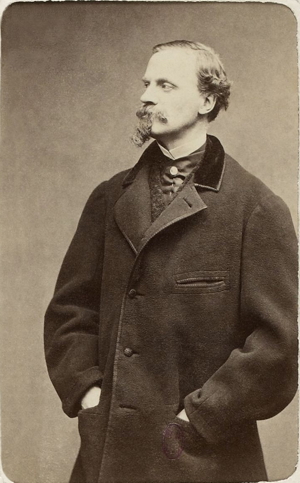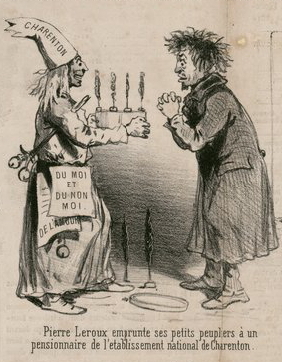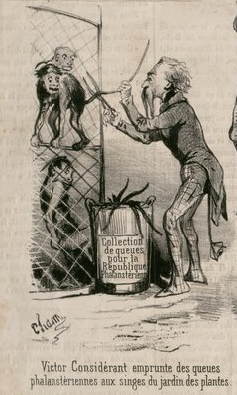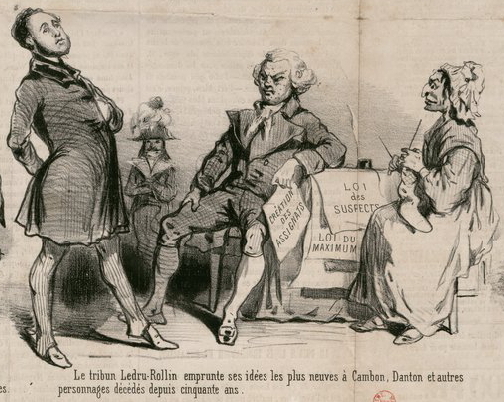
"New" Socialist Ideas in 1848
[Created: 15 July, 2014]
[Updated: July 21, 2022 ] |
Anti-Socialist Cartoon by Amédée de Noé (1848)
Amédée de Noé, dit Cham, “Ce qu’on appelle des idées nouvelles en 1848” (Paris?: Imp. Aubert & Cie, 1848). Lithograph (26.5 x 41.1 cm). Bibliothèque nationale de France http://catalogue.bnf.fr/ark:/12148/cb41520291k.

Introduction
Sometime during 1848 the 30 year old French caricaturist Amédée de Noé (1818-1879) (nicknamed "Cham") drew this panel of six anti-socialist cartoons in which he ridiculed the claims of leading advocates of socialism that their ideas were new and that they were the key to solving France's economic and political problems. He directs his barbs against the following individuals:
- Pierre-Joseph Proudhon
- Pierre Leroux
- Étienne Cabet
- Victor Considerant
- Alexandre Auguste Ledru-Rollin
- Louis Napoléon Bonaparte
Socialist ideas had developed considerably durting the 1840s with the work of the following;
- Proudhon, Qu’est-ce que la propriété? ou Recherches sur le principe du Droit et du Gouvernement (1840)
- Louis Blanc, Organisation du travail. Association universelle. Ouvriers (1841)
- Victor Considerant, Droit de propriété et du droit au travail (1848)
- Louis Blanc, Le Socialisme. Droit au travail, réponse à M. Thiers (1848)
- Pierre Joseph Proudhon, Le droit au travail et le droit de propriété (1850)
Their criticism of the free market and wage labour centred on a number of points, such as
- Smithian/Ricardian labour theory of value (labour was main source of the creation of value, workers not given full value of their labour, profits to owners was therefore “unearned”) and
- “unearned” nature of land rent (gift of soil, sun), therefore rent was wrong and should be eliminated or reduced, or land redistributed to propertyless
- Malthusianism - inevitable impoverishment of the WC due to population pressure
The socialists' criticism was countered by the political economists who came to the defense of the free market and private property in the following works:
- Charles Dunoyer, La Liberté du travail (1845)
- F. Bastiat, Economic Sophisms I (1846) and II (1848)
- Adolphe Thiers, Discours prononcé à l’Assemblée Nationale sur le droit au travail (1848)
- Adolphe Thiers, De la propriété (1848)
- Léon Faucher, Du droit au travail (1848)
- Michel Chevalier, Lettres sur l’Organisation du travail (1848)
- Frédéric Bastiat’s series of 12 anti-socialist pamphlets (1848–1850)
- Molinari, Les Soirées (1849)
- Bastiat and Proudhon, Gratuité du crédit (Oct. 1849 - Feb. 1850)
The econiomists developed a thorough-going critique of socialism, the main points of which are still used today. These included the following:
- the incentive problem: communally organised living and working arrangements destroy incentives for individuals to work hard, all profits go to community to be equally distributed
- division of labour problem: people with key skills (managerial, financial, technical, organisational, entrepreneurial) need to be paid for their extra contribution to productive process
- the risk problem: all economic activity involves risks (loss, miscalculation, natural disaster) which needs to be rewarded
- injustice of expropriation: to create socialist system existing justly owned property has to be confiscated and given to new communally organised groups
- individual liberty problem: soicalists envisaged new communal institutions would be organised like army or govt bureaucracy - hierarchical, command from above, communal eating and sleeping arrangements
- human nature problem: socialists assumed human nature is not fixed but malleable, possible to create “new socialist man”; economists believed humans were social but not communist, self-interested (broadly understood) not willing to sacrifice their interests to the community’s; humans vastly different in tastes, preferences, skills, and interests
- the public choice problem - rulers not disinterested parties but have own agendas
- problem of ignoring economic laws - economy governed by economic laws (such as law of supply and demand) which cannot be ignored or wished away either by well meaning people or by economic predators.
Gustave de Molinari in his book Les Soirées (1849) identified 6 natural laws of political economy:
- “la loi naturelle de l’économie des forces ou du moindre effort” (the natural law of the economising of forces, or of the least effort) - by this he meant that individuals attempted to gain the most that they could with the least amount of effort.
- “la loi naturelle de la concurrence” (the natural law of competition) or “la loi de libre concurrence” (the law of free competition) - Molinari thought that there was a Darwinian struggle for survival by all living creatures. In the case of human beings, this competition could be either “productive competition” in the case of industrial or economic activity, or “destructive competition” in the case of war or politics.
- “la loi naturelle de la valeur” (sometimes also expressed as “la loi de progression des valeurs”) (the natural law of value, or the progression of value) - by this Molinari meant that in a free market the price of goods and services will be lowered as a result of competition to their “natural value” or cost of production.
- “la loi de l’offre et de la demande” (the law of supply and demand) which he also sometimes called “la loi des quantités et des prix” (the law of supply and prices) - this was short hand for saying that prices vary according to their supply and demand in the market place and that both consumers and producers alter their behavior as a result.
- “la loi de l’équilibre” (the law of economic equilibrium) - which is Molinari’s version of Bastiat’s theory of Harmony, that if markets are left free to function they will tend to produce order not chaos, and there will arise a balance between the demand for products by consumers and the supply of those products by producers
- “Malthus’ law of population growth”
Molinari also distinguished between two different kinds of socialism, “socialism from below” (which was democratic and republican republican and advocated during 1848 by people like Louis Blanc, Pierre Leroux, Étienne Cabet, and Victor Consideran) and “socialism from above” (which was adopted by an alliance of bureaucrats, Bonapartists, militarists, crony capitalists, and whose main advocagtes were politicians such as Alexandre Auguste Ledru-Rollin and Louis Napoléon Bonaparte).
Molinari's colleague Frédéric Bastiat also contributed greatly to the debate about socialism in the period between 1848 and his death in late 1850. It was at the height of the socialist rioting in june 1848 that he wrote perhaps his most important essay "The State" which later became a pamphlet. One of his insights into the nature of the State was that exploitation by a small ruling elite made some economic sense in that the mass of consumers and taxpayers wwere forced to pay subsidies and benefits to small group of beneficiaries (e,g, slaves vs. the slave owners, consumers vs. the owners of protected industries). The net transfer of wealth from the majority to the minorty made some political and economic sense. However, the transfers of wealth and property envisaged by the socialisgs in 1848,or what one might call democratic or socialist “exploitation” made no sense because everybody couldn’t benefit from taxing everybody else (including themselves). He asked, if all were paying taxes or higher prices how could everybody benefit? From this Bastiat developed his definition of state “as the great fiction whereby everybody tries to live at the expense of everybody else”. He (and other liberals like Molinari) concluded that the net beneficiaries, even ina democratic, republican, socialist state would be those who worked for the state or ran it, orwho were friends of those who ran it. Both also began to develop the "public choice" insight that politicians and bureaucrats are self-interested and pursue agendas which are not the same as the “interests of the people,” which was the rather naive view of the socialists in 1848.
Amédée de Noé mocked both these types of socialism in his cartoon. This first image shows the entire panel of 6 caroons. The smaller images which follow are close ups of the individual cartoons with some explanation of the socialist concerned, their ideas, and some historical context to help explain the joke.
“Ce qu’on appelle des idÉes nouvelles en 1848” (What are called New Ideas in 1848)

1. Pierre-Joseph Proudhon, the demolition expert:

1. The anarchist-socialist Pierre-Joseph Proudhon, carrying a pick with which he destroys the foundations of the free market, is confronted by the Greek playwright Aristophanes, a Greek legislator, and a Roman soldier, who accuse him of having plagiarised their ideas about property being a form of theft and the need for agrarian laws to forcibly redistribute property among the poor. Proudhon wrote a very influential book in 1840 called "Qu'est-ce que c'est la propriété?" (What is Property?) to which he gave the notorious answer "Property is theft". In 1848-49 he attempted to establish a People's Bank which would be funded by subscriptions and make zero or low interest rate loans to workers, since he believed that charging interest on loans was unjust. It failed because it was unable to raise sufficient capital to open.
2. Pierre Leroux, the madman:

2. The socialist Pierre Leroux invented the word "socialist" to describe his ideal community in which everybody enjoyed liberty and equality without the injustices he believed were created by private property and the free market. He was elected to the Constituent Assembly in 1848 and drew up an elaborate proposal for a new constitution based upon socialist ideas. All aspects of the new society had to be drawn up in advance by the legislators, including the flag, the colours of clothing people were allowed to wear, and the national tree which had to be planted everywhere. The national colours were to be white, gold, azure, and purple and each of the main divisions of government would require the citizens who worked in it to wear the colour corresponding to their division - white for administrators, gold for those who worked in scientific occupations, azure for those who worked for the legislative branch of government, and purple for the executive branch. Outside of working hours, all citizens had to wear all four colours of the national flag to show their solidarity with the state. Leroux also chose the poplar tree as the state tree because its shape best exemplified the similarity and equality of all citizens. Every Commune in France would be required to plant rows of identical popular trees in order to make this point clear to the citizenry. In the cartoon a very grateful looking Leroux receives a gift of 4 small poplar trees by an inmate of the largest insane asylum in France - "Charenton." He is wearing bells which he uses to warn people that he is mad and that they should keep away from him. He is also carrying signs which refer to the philosophical idea of the self (the me) and the non-self (non-moi) perhaps suggesting that Leroux's socialist ideas would lead to the destruction of "the self" if his ideas about egality were implemented.
3. Étienne Cabet, the pilrim and his gullible followers:

3. The utopian socialist Étienne Cabet believed in the equality of property ownership and the strict regulation and control of all economic activity by elected representatives of the community. He wrote a book in 1840 about his ideal society, called "Icarus", and went to America in 1848 in order to put his ideas into practice with communities in Texas, Illinois, and Missouri. In this cartoon Cabet is dressed like a pilgrim and is sitting on an empty contribution box, reading his book on Icarus. He is surrounded by hungry birds called "gobe-mouche" (fly gobblers) which also means someone who is very gullible. Posters on the wall refer to other failed attempts to set up communities or businesses in America. John Law was a Scottish financier who worked for Louis XV to set up the first central bank funded by fiat paper money, believing that paper money was preferable to gold. He consolidated all the government chartered companies in French-controlled Louisiana into one monopoly company called the Mississippi Company which issued shares. An over issue of these shares caused a speculative bubble which burst catastrophically in 1720. The Champs d'asile was a community established in Texas in 1817 for veterans of Napoleon's defeatd Grande Armée. It failed the following year. The reference to "Gobemoucherie de 1785" is not clear. Note that an alligator from Louisiana or Texas has swallowed one of the "gobe-mouche."
4. Victor Considerant, the creator of a “new socialist man”:

4. Victor Considerant was a follower of the socialist Fourier and was the leading advocate of "the right to work" which the socialists attempted to enact in the early months of the 1848 Revolution. Fourier and Considerant believed that the creation of socialist communities and socialist ways of living and working would create a new kind of human being with different moral values (selfishness would disappear) and even new physical features. To bring this about people would be forced to live in small communities known as "phalansteries" which would house about 1,600 individuals who would live and work together communally. Fourier believed that the institution of monogamous marriage would eventually disappear and would be replaced by a system of free love. Considerant believed that human's physical shape would gradually change when they lived in highly regulated socialist communities. The cartoon refers to his idea that humans might eventually evolve "queues" (tails) which had an eye at the end of it. Considerant has such a tail and has gone to the monkey cage in the botanical gardens (zoo?) to cut off the monkey's tails to add to his collection for the new "Phalansterian Republic."
5. Alexandre Auguste Ledru-Rollin, who dreams of a new socialist Terror:

5. The 1848 revolutionary politician Alexandre Auguste Ledru-Rollin struts before Danton who was a political leader during the French Terror 1792-94. Danton leans against some of his most important revolutionary legislation such as the law issuing paper money (assignats), price controls (the "Maximum"), and the law imprisoning suspected enemies of the revolution. Ledru-Rollin when he was in the Provisional Government supported a 45% increase in taxes, the "right to a job" legislation, and the suspension of payments in gold by the central bank. To the right sits one of the notorious "knitting ladies" who supposedly sat watching the beheading of aristocrats, profiteers, and other enemies of the Revolution during the Terror.
6. Louis Napoléon Bonaparte, the socialist “Prince-President”:

6. Napoleon Bonaparte wearing his underwear, gives his nephew Louis Napoleon his sword, grey coat and hat. Louis Napoléon was elected President of the Second Republic in December 1848 but had ambitions to become the dictator of France. He began calling himself the "Prince-President" and later seized power in a coup d'état in December 1851 and then suspended the constitution and declared himself emperor in December 1852. He was influenced by the socialist and interventionist ideas of Saint-Simon.